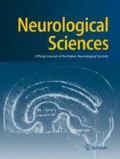Abstract
Premenstrual syndrome (PMS) includes a wide variety of physical, psychological, and cognitive symptoms that occur recurrently and cyclically during the luteal phase of the menstrual cycle and disappear soon after the onset of menstruation. Headache, often of migrainous type, is one of physical symptoms often reported in the diagnostic criteria for PMS. Menstrual migraine (MM) is a particular subtype of migraine occurring within the 2 days before and the 3 days after the onset of menses. According to this definition, therefore, some attacks of MM certainly occur in conjunction with the period of maximum exacerbation of PMS symptoms. The relationship between MM and PMS has been investigated through diary-based studies which have confirmed the possible correlation between these two conditions. In this paper we provide indications for the treatment of MM, making particular reference to those therapies that may be useful in the treatment of PMS symptoms. Even if triptans are the gold standard for the acute treatment, if symptomatic treatment is not sufficient one can resort to a short-term perimenstrual prophylaxis. Non-steroidal anti-inflammatory drugs have been demonstrated effective in MM prophylaxis. Among natural products there is some evidence of efficacy for magnesium, phytoestrogens, and ginkgolide B. Finally, also a combined oral contraceptive containing drospirenone, taken continuously for 168 days, has shown promising results.
Similar content being viewed by others
Abbreviations
- COC:
-
Combined oral contraceptive
- DSM:
-
Diagnostic and Statistical Manual of Mental Disorders
- MDQ:
-
Menstrual Distress Questionnaire
- Mg:
-
Magnesium
- MM:
-
Menstrual migraine
- NSAIDs:
-
Non-steroidal anti-inflammatory drugs
- PMDD:
-
Premenstrual dysphoric disorder
- PMS:
-
Premenstrual syndrome
- RCT:
-
Randomized controlled trial
- TTH:
-
Tension-type headache
- WHO:
-
World Health Organization
References
Martin VT, Wernke S, Mandell K et al (2006) Symptoms of premenstrual syndrome and their association with migraine headache. Headache 46(1):125–137
Johnson SR (2004) Premenstrual syndrome, premenstrual dysphoric disorder, and beyond: a clinical primer for practitioners. Obstet Gynecol 104(4):845–859
Halbreich U, Backstrom T, Eriksson E et al (2007) Clinical diagnostic criteria for premenstrual syndrome and guidelines for their quantification for research studies. Gynecol Endocrinol 23(3):123–130
World Health Organization (WHO) (1996) International classification of diseases, 10th revision. WHO, Geneva
American College of Obstetricians and Gynecologists (2000) Premenstrual syndrome. National Guideline Clearinghouse, Washington, DC
American Psychiatric association (APA) (1994) Diagnostic and statistical manual of mental disorders, 4th edn. Washington, DC, pp 714–718
Royal College of Obstetricians and Gynaecologists (2007) Management of premenstrual syndrome. Green-top Guideline No. 48
Fragoso YD, Guidoni AC, de Castro LB (2009) Characterization of headaches in the premenstrual tension syndrome. Arq Neuropsiquiatr 67(1):40–42
Beckham JC, Krug LM, Penzien DB et al (1992) The relationship of ovarian steroids, headache activity and menstrual distress: a pilot study with female migraineurs. Headache 32(6):292–297
Facchinetti F, Neri I, Martignoni E et al (1993) The association of menstrual migraine with the premenstrual syndrome. Cephalalgia 13(6):422–425
Sances G, Martignoni E, Fioroni L et al (1990) Naproxen sodium in menstrual migraine prophylaxis: a double-blind placebo controlled study. Headache 30(11):705–709
Al-Waili NS (2000) Treatment of menstrual migraine with prostaglandin synthesis inhibitor mefenamic acid: double-blind study with placebo. Eur J Med Res 5(4):176–182
Facchinetti F, Fioroni L, Sances G et al (1989) Naproxen sodium in the treatment of premenstrual symptoms. A placebo-controlled study. Gynecol Obstet Invest 28(4):205–208
Wood C, Jakubowicz D (1980) The treatment of premenstrual symptoms with mefenamic acid. Br J Obstet Gynaecol 87(7):627–630
Mira M, McNeil D, Fraser IS et al (1986) Mefenamic acid in the treatment of premenstrual syndrome. Obstet Gynecol 68(3):395–398
Facchinetti F, Sances G, Borella P et al (1991) Magnesium prophylaxis of menstrual migraine: effects on intracellular magnesium. Headache 31(5):298–301
Facchinetti F, Borella P, Sances G et al (1991) Oral magnesium successfully relieves premenstrual mood changes. Obstet Gynecol 78(2):177–181
Fathizadeh N, Ebrahimi E, Valiani M et al (2010) Evaluating the effect of magnesium and magnesium plus vitamin B6 supplement on the severity of premenstrual syndrome. Iran J Nurs Midwifery Res 15(Suppl 1):401–405
De Souza MC, Walker AF, Robinson PA et al (2000) A synergistic effect of a daily supplement for 1 month of 200 mg magnesium plus 50 mg vitamin B6 for the relief of anxiety-related premenstrual symptoms: a randomized, double-blind, crossover study. J Womens Health Gend Based Med 9(2):131–139
Burke BE, Olson RD, Cusack BJ (2002) Randomized, controlled trial of phytoestrogen in the prophylactic treatment of menstrual migraine. Biomed Pharmacother 56(6):283–288
Ferrante F, Fusco E, Calabresi P et al (2004) Phyto-oestrogens in the prophylaxis of menstrual migraine. Clin Neuropharmacol 27(3):137–140
Bryant M, Cassidy A, Hill C et al (2005) Effect of consumption of soy isoflavones on behavioural, somatic and affective symptoms in women with premenstrual syndrome. Br J Nutr 93(5):731–739
Ozgoli G, Selselei EA, Mojab F et al (2009) A randomized, placebo-controlled trial of Ginkgo biloba L. in treatment of premenstrual syndrome. J Altern Complem Med 15(8):845–851
D’Andrea G, Bussone G, Allais G et al (2009) Efficacy of Ginkgolide B in the prophylaxis of migraine with aura. Neurol Sci 30(Suppl 1):S121–S124
Esposito M, Carotenuto M (2011) Ginkgolide B complex efficacy for brief prophylaxis of migraine in school-aged children: an open-label study. Neurol Sci 32(1):79–81
Lopez LM, Kaptein AA, Helmerhorst FM (2012) Oral contraceptives containing drospirenone for premenstrual syndrome. Cochrane database of systematic reviews 2. Art. No.:CD006586. doi:10.1002/14651858.CD006586.pub4
Sulak PJ, Kuehl TJ, Ortiz M et al (2002) Acceptance of altering the standard 21-day/7-day oral contraceptive regimen to delay menses and reduce hormone withdrawal symptoms. Am J Obstet Gynecol 186(6):1142–1149
Conflict of interest
None.
Author information
Authors and Affiliations
Corresponding author
Rights and permissions
About this article
Cite this article
Allais, G., Castagnoli Gabellari, I., Burzio, C. et al. Premenstrual syndrome and migraine. Neurol Sci 33 (Suppl 1), 111–115 (2012). https://doi.org/10.1007/s10072-012-1054-5
Published:
Issue Date:
DOI: https://doi.org/10.1007/s10072-012-1054-5



